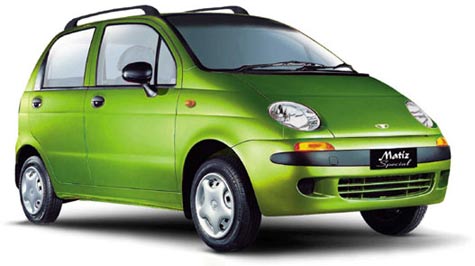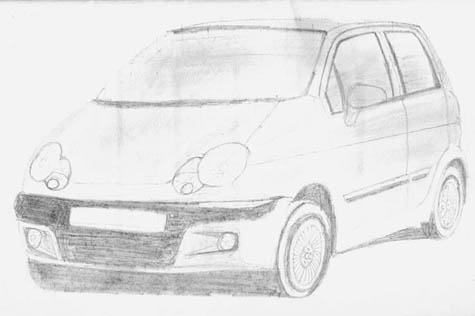Daewoo Matiz

 Europe's
Best Small Car, last year, the Matiz is one of the best looking cars on
Indian roads, or rather around the world, today. Not surprising
considering that Daewoo had given the job of styling to Giugiaro of
Italdesign. Incidentally, the Matiz's shape is based on the Lucciola
concept car, which was offered to Fiat as a replacement for the
Cinquecento. Fiat's loss is certainly Daewoo's gain. The Matiz has turned
out to be a design that transcends class and forces a smile and
appreciation from even the stuffiest sorts. The short bonnet, which holds
the cute Bettle-like lamps and the absence of a grille, characterises the
front. The classy winged taillights are distinctive as well but intrude
into the loading area of the rear hatch. Still the car is unquestionably
the best-packaged car in India today. The tight packaging of the engine
and the stretch of the A-pillar give it a semi-monospace design that
maximises passenger space. The long front door is an indication of this. A
disappointment is luggage space, which is nowhere near as generous as
passenger room. The Matiz uses conventional MacPherson struts in front
with the rear springs that hark back to the Daewoo Tico, originally a
Suzuki Alto (Maruti 800). In terms of build quality, the Matiz impresses
with the well-aligned body panels, a fabulous paint job and a rigid and
rattle-free bodyshell. The 796cc three-cylinder block is similar to the
Maruti 800, with an identical bore and stroke of 68.5x72mm. This is one of
the few carryover parts from the Tico. However, the top half of the M-Tech
engine is virtually all-new design developed by Tickford of UK and
Daewoo's technical centre in Germany. Though it maintains a conventional
two-valve per head layout in the interests of costs and simplicity, this
M-Tect motor comes with other high-tech hardware like a thermoplastic
manifold, torque rail shift engine mounts and clip-type retainers for
valve springs. A high performance camshaft and a sophisticated multi-point
fuel injection (MPFI) system pushes power up to a claimed 52bhp @ 6200rpm
and if these figures are true, it's pretty impressive for an 800cc, three
pot engine. On a drag strip the Matiz takes a little over 20sec to touch
three-figure speeds. The three-cylinder engine, though pretty refined at
idle, feels decidedly coarse when intended through its rev range. However,
the perky throttle
response and very short gearing of the Matiz makes it easy to punt around
in town. The interiors are a revelation the minute you step in through the
large front doors. Ergonomically, the Matiz is spot on, with the controls
falling nicely to hand and a driving position and seat comfort that are
well suited to most bodyframes. The view through the MPV-like distant
windscreen is good but the forward-sitting A-pillars tend to obstruct
vision while cornering. At the rear, legroom is terrific for a car of this
size. The brilliant packaging of the Matiz and semi-monospace design
allows the front seats to be positioned acutely forward. This lib
Europe's
Best Small Car, last year, the Matiz is one of the best looking cars on
Indian roads, or rather around the world, today. Not surprising
considering that Daewoo had given the job of styling to Giugiaro of
Italdesign. Incidentally, the Matiz's shape is based on the Lucciola
concept car, which was offered to Fiat as a replacement for the
Cinquecento. Fiat's loss is certainly Daewoo's gain. The Matiz has turned
out to be a design that transcends class and forces a smile and
appreciation from even the stuffiest sorts. The short bonnet, which holds
the cute Bettle-like lamps and the absence of a grille, characterises the
front. The classy winged taillights are distinctive as well but intrude
into the loading area of the rear hatch. Still the car is unquestionably
the best-packaged car in India today. The tight packaging of the engine
and the stretch of the A-pillar give it a semi-monospace design that
maximises passenger space. The long front door is an indication of this. A
disappointment is luggage space, which is nowhere near as generous as
passenger room. The Matiz uses conventional MacPherson struts in front
with the rear springs that hark back to the Daewoo Tico, originally a
Suzuki Alto (Maruti 800). In terms of build quality, the Matiz impresses
with the well-aligned body panels, a fabulous paint job and a rigid and
rattle-free bodyshell. The 796cc three-cylinder block is similar to the
Maruti 800, with an identical bore and stroke of 68.5x72mm. This is one of
the few carryover parts from the Tico. However, the top half of the M-Tech
engine is virtually all-new design developed by Tickford of UK and
Daewoo's technical centre in Germany. Though it maintains a conventional
two-valve per head layout in the interests of costs and simplicity, this
M-Tect motor comes with other high-tech hardware like a thermoplastic
manifold, torque rail shift engine mounts and clip-type retainers for
valve springs. A high performance camshaft and a sophisticated multi-point
fuel injection (MPFI) system pushes power up to a claimed 52bhp @ 6200rpm
and if these figures are true, it's pretty impressive for an 800cc, three
pot engine. On a drag strip the Matiz takes a little over 20sec to touch
three-figure speeds. The three-cylinder engine, though pretty refined at
idle, feels decidedly coarse when intended through its rev range. However,
the perky throttle
response and very short gearing of the Matiz makes it easy to punt around
in town. The interiors are a revelation the minute you step in through the
large front doors. Ergonomically, the Matiz is spot on, with the controls
falling nicely to hand and a driving position and seat comfort that are
well suited to most bodyframes. The view through the MPV-like distant
windscreen is good but the forward-sitting A-pillars tend to obstruct
vision while cornering. At the rear, legroom is terrific for a car of this
size. The brilliant packaging of the Matiz and semi-monospace design
allows the front seats to be positioned acutely forward. This lib erates
tremendous legroom, more than even the Cielo. Rear seat comfort is good
thanks to an optimally reclined backrest and soft ride. Again, the luggage
area is disappointing, which is similar in size to the Zen. The stylish
rear taillights, which intrude into the loading area, do not help. The
Matiz has been designed primarily for urban use. It makes light work of
traffic thanks to its compact dimensions and good driveability. In term
soft low-speed ride, the Matiz is on the softer side and is very
compliant. At high speeds, however, the Matiz pitches excessively and is
easily ruffled by rough and bumpy roads. Fuel efficiency is one of its
strong points. Figures of 12.4kpl and 17.8kpl in the city and on the
highway can be returned without much ado.
erates
tremendous legroom, more than even the Cielo. Rear seat comfort is good
thanks to an optimally reclined backrest and soft ride. Again, the luggage
area is disappointing, which is similar in size to the Zen. The stylish
rear taillights, which intrude into the loading area, do not help. The
Matiz has been designed primarily for urban use. It makes light work of
traffic thanks to its compact dimensions and good driveability. In term
soft low-speed ride, the Matiz is on the softer side and is very
compliant. At high speeds, however, the Matiz pitches excessively and is
easily ruffled by rough and bumpy roads. Fuel efficiency is one of its
strong points. Figures of 12.4kpl and 17.8kpl in the city and on the
highway can be returned without much ado.
|
Technical Specification |
|
| Engine Control |
Electronic Control Unit With MPR |
| Emission Control |
3-way Catalytic Converter with ceramic Honeycomb substrate |
| Power | 52 bhp @ 6000 rpm |
| Torque | 7.3 kg.m @ 3500 rpm |
| Dimensions & Capacities: | |
| Wheelbase | 2340 mm |
| Track Front/Rear | 1315/1280 mm |
| Length | 3495 mm |
| Width | 1495 mm |
| Height | 1505 mm |
| Ground Clearance | 170 mm |
| Kerb Weight | 800 kg |
| Fuel Tank Capacity | 35 litres |
| Head Room Front/Rear | 995/935 mm |
| Leg Room Front/Rear | 1039/895 mm |
| Shoulder Room | 1275 mm |
| Suspension: | |
| Front | McPherson Struts |
| Rear | Isolated Trailing Links |
| Steering Type | Rack & Pinion |
| Turning Radius | 4.5 m |
| Brakes: | Dual Diagonal Circuit |
| Front | Disc |
| Rear | Drum |
| Tyre Size | 145/70 R13 |
| Performance | |
| Maximum Speed | 144 kmph |
 There
are numbers of options available by which one can modify their Matiz,
depending on their requirements, preferences and budget. One
can change tod-like headlights with daul clear headlights which are easily
available in the local market. The front can be modified in order to give
Matiz a Macho looks.
There
are numbers of options available by which one can modify their Matiz,
depending on their requirements, preferences and budget. One
can change tod-like headlights with daul clear headlights which are easily
available in the local market. The front can be modified in order to give
Matiz a Macho looks.